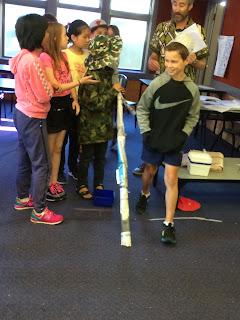There was a lot of group discussion and problem solving involved. Some groups realised at the end of the challenge that they need to read instructions more clearly before they even start the task.
Monday, 20 March 2017
Friday technology challenge
At the end of last week, student groups took part in a tech challenge where they had to build a table tennis grabber with limited materials - mainly newspaper, some straws, string and tape. Their device had to reach over a 2 metre gap, pick up a table tennis ball and bring it back.
There was a lot of group discussion and problem solving involved. Some groups realised at the end of the challenge that they need to read instructions more clearly before they even start the task.
There was a lot of group discussion and problem solving involved. Some groups realised at the end of the challenge that they need to read instructions more clearly before they even start the task.
Saturday, 11 March 2017
Spelling Word Lists
Here is the link to our spelling lists on Spelling City.
You want to start on list 4 and work your way up from there.
If there are words that you get incorrect then make sure you take a note of these and go back to learn them.
Here is the link to our lists for Spelling City.
If you need to learn some words of the list then make use this flow diagram to help you.
You want to start on list 4 and work your way up from there.
If there are words that you get incorrect then make sure you take a note of these and go back to learn them.
Here is the link to our lists for Spelling City.
If you need to learn some words of the list then make use this flow diagram to help you.
Articles relating to the Treaty of Waitangi
Here are links to some of the articles for Treaty of Waitangi.
There are a range to choose from and you are not expected to read all of them! In your group select a link and summarise information you have read.
What do you know already?
What new information have you gained?
Are there burning questions you have after reading the article?
For video links go into Ngaio Classroom by clicking on this link.
There are a range to choose from and you are not expected to read all of them! In your group select a link and summarise information you have read.
What do you know already?
What new information have you gained?
Are there burning questions you have after reading the article?
For video links go into Ngaio Classroom by clicking on this link.
Monday, 6 March 2017
Positional Language in Te Reo Maori
Here is a slideshow to help you remember your positional vocabulary.
Building maths knowledge at home
We set up a website last year with links to our maths knowledge areas. It focuses on basic facts, fractions, place value and number sequences. It is used in small bursts at school to support their maths learning.
Students can also use this website at home with links to games to maintain their knowledge and videos that will explain strategies they are learning.
Here is the link:
Students can also use this website at home with links to games to maintain their knowledge and videos that will explain strategies they are learning.
Here is the link:
Sunday, 5 March 2017
Number Boggle
How many equations can you make from this number boggle?
You can add, subtract, multiply and divide to get the answer.
Students often begin with 2 or three numbers but as they get more skilled with boggle can use up to 7 or 8. We will be using number boggle as one of our can do activities during maths for the next two weeks.
The only rule is that the numbers have to touch either sideways,above below or on a corner. For example using the top row: 9+7=16 16-6=10 10+2=12
How many equations could you make using?
What is the longest equation?
You can add, subtract, multiply and divide to get the answer.
Students often begin with 2 or three numbers but as they get more skilled with boggle can use up to 7 or 8. We will be using number boggle as one of our can do activities during maths for the next two weeks.
The only rule is that the numbers have to touch either sideways,above below or on a corner. For example using the top row: 9+7=16 16-6=10 10+2=12
THE TARGET NUMBER FOR THIS BOGGLE IS A TOTAL OF 12
How many equations could you make using?
What is the longest equation?
Wednesday, 1 March 2017
Videos to introduce the Treaty of Waitangi
Here are a couple of videos that we watched to introduce ourselves to the Treaty of Waitangi.
After an initial discussion we realised that we knew very little about the Treaty and found these two videos as an introduction. They mainly focus on the build up to the treaty signing. Some of the words we don't understand yet... but we will be working to find out and make connections with information we are reading around this subject.
After an initial discussion we realised that we knew very little about the Treaty and found these two videos as an introduction. They mainly focus on the build up to the treaty signing. Some of the words we don't understand yet... but we will be working to find out and make connections with information we are reading around this subject.
Subscribe to:
Comments (Atom)





























